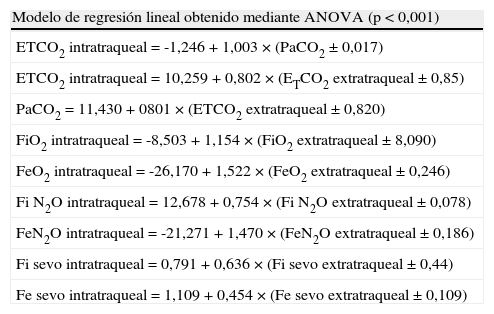Diseñamos una sonda endotraqueal para medir fracciones inspiradas y espiradas de los gases de la mezcla durante anestesia general pediátrica.
ObjetivosComparar los gases analizados en el circuito, mediante monitorización intra y extratraqueal, y comprobar sus posibles diferencias.
Material y métodosPacientes de 7 a 12 años; ASA I; bajo anestesia inhalatoria en ventilación mecánica. Se analizan dentro y fuera de la tráquea, fracciones inspiradas (Fi) y espiradas (Fe) de O2/N2O/Sevoflurano; la relación Fe/Fi; presión arterial de CO2 (PaCO2); y end tidal CO2 (ETCO2); mediante medición previa al tubo endotraqueal (TET) desde pedilite, y mediante sonda en tráquea, anterior a la carina y posterior al TET. Ambos dispositivos fueron conectados al mismo monitor. Se realizaron mediciones en inicio, 5’, 10’, 15’, 20’, 30’, 40’, 50’ y 60 minutos tras intubación, y de PaCO2 en los mismos tiempos. Se compararon valores medios (T Student), coeficiente correlación de Pearson (r), y se determinaron modelos de regresión (ANOVA).
ResultadosIncluimos 71 pacientes. La diferencia media (DE) de ETCO2 fue 5(±3)mmHg superior para la medición endotraqueal (p<0,005), casi coincidente (±1,3mmHg) con la PaCO2 (p≤0,5). Los gradientes (DE) de Fi-Fe O2/N2O fueron 3 (±2) puntos superiores en la medición endotraqueal (p<0,05). Sin embargo, sevoflurano presentó diferencia media extratraqueal superior 0,6 (±0,2) puntos (p<0,05). Conforme avanza el tiempo anestésico, los gradientes Fi-Fe O2/N2O, se equiparan transcurridos 18 (±3) minutos, para sevoflurano esto sucede en 8 (±2) minutos.
ConclusionesLas fracciones inspiradas y espiradas de los gases de la mezcla son distintos, según se realice la medición intra o extratraqueal.
We designed an endotracheal probe for measuring inspired and expired gas fractions during pediatric general anesthesia.
ObjectiveTo compare the gas fractions measured by means of intratracheal and extratracheal monitoring.
Material and methodsThe study included ASA 1 patients between the ages of 7 and 12 years under inhaled anesthesia with mechanical ventilation. The following para-meters were recorded inside and outside the trachea: inspired and expired oxygen, nitric oxide (N2O) and sevoflurane fractions; the expired and inspired fraction gradients; PaCO2; and end-tidal carbon dioxide (ETCO2). Measurements were taken by an airflow sensor (Pedi-Lite) in the circuit before the point of connection to the endotracheal tube and by an intratracheal probe placed between the tube and the carina. Both sensors were connected to the same monitor. Measurements were taken on intubation and 5, 10, 15, 20, 30, 40, 50, and 60 minutes thereafter. PaCO2 was recorded at the same time. The recorded values were analyzed using the t test and the Pearson product moment correlation coefficient (r), and regression models were constructed using analysis of variance.
ResultsSeventy-one patients were enrolled in the study. The mean difference (SD) ETCO2 was 5 (3)mm Hg higher according to endotracheal measurement (P<.005), and that measurement was almost identical (±1.3mm Hg) to the PaCO2 (P≤.5). The inspired/expired gradients of endotracheal measurement of oxygen and N2O were 3 (2) points higher (P<.05) than the gradients of extratracheal measurements. In the case of sevoflurane gradients, however, the extratracheal values were higher (mean difference, 0.6 [0.2] points, P<.05). The inspired/expired oxygen and N2O gradients became equal after 18 (3) minutes; the sevoflurane gradients became equal after 8 (2) minutes.
ConclusionsIntratracheal and extratracheal measurements of the inspired and expired fractions of mixed gases provide different results.















